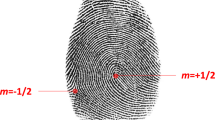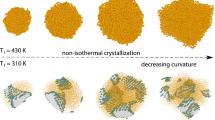Abstract
A viewpoint is developed that formation of a hole in amorphous substances corresponds to the atom delocalization process, i.e., its fluctuation limiting shift from the temporary equilibrium state. The molecular-kinetic processes proceeding in liquids and amorphous rigid solids do not depend on the classical van der Waals free volume, “void statistical space between atoms,” but mainly depend on the fluctuation dynamic free volume, which coincides with the fluctuation free volume caused by the atom delocalization. The atom delocalization process (local configuration structural change) plays the key role in the viscous flow of glass-forming liquids. The softening of glasses (at Tg) and their frozen reversible deformation (at 20°C) are characterized by the same molecular mechanism, namely, the atom delocalization. From the same positions as noted above, the effect of plasticity of inorganic glasses and amorphous organic polymers was considered.




Similar content being viewed by others
REFERENCES
Ya. I. Frenkel’, Kentic Theory of Liquids (Izd-vo AN SSSR, Moscow; Leningrad, 1945) [in Russian].
S. Glesston, K. Leidler, and G. Eiring, Theory of Absolute Reaction Rate (Izd-vo Inostr. Lit, Moscow, 1948) [in Russian].
D. S. Sanditov and G. M. Bartenev, Physical Properties of Disordered Structures (Nauka, Novosibirsk, 1982) [in Russian].
J. Ferry, Viscoelastic Properties of Polymers (Wiley, New York; London, 1961).
V. G.Rostiashvili, V. I. Irzhak, and B. A. Rozenberg, Glass Transitions in Polymers (Khimiya, Leningrad, 1987) [in Russian].
V. I. Betekhtin, A. G. Kadomtsev, A. Yu. Kipyatkova, and A. M. Glezer, Phys. Solid State 40, 74 (1998).
D. S. Sanditov and S. Sh. Sangadiev, Vysokomol. Soedin., Ser. A 41, 977 (1999).
J. Bartos, K. Kristiakova, O. Sausa, and J. Kristiak, Polimer 37, 3397 (1996).
L. A. Moulinier, in Polymer Physics: From Suspensions to Nanocomposites and Beyond, Ed. by L. A. Utracki and A. M. Jameson (Wiley, Hoboken, 2010).
T. Egami, Prog. Mater. Sci. 56, 637 (2011).
Z. George, J. Appl. Phys. 119, 225104 (2016).
R. E. Robertson, R. Simha, and J. G. Curro, Macromolecules 17, 911 (1984).
G. Dlubek, in Polymer Physics: From Suspensions to Nanocomposites and Beyond, Ed. by L. A. Utracki and A. M. Jameson (Wiley, Hoboken, 2010).
M. H. Cohen and G. S. Grest, Phys. Rev. B 20, 1077 (1979).
M. Di Michiel and A. Kvick, Acta Mater. 53, 1611 (2005).
D. S. Sanditov, J. Exp. Theor. Phys. 115, 112 (2012).
D. S. Sanditov and S. S. Badmaev, Glass Phys. Chem. 41, 460 (2015).
G. L. Slonimskii, A. A. Askadskii, and A. I. Kitaigorodskoi, Vysokomol. Soedin., Ser. A 12, 494 (1970).
A. V. Lysenko, V. A. Lyakhov, V. A. Khonik, and M. Yu. Yazvitskii, Phys. Solid State 51, 221 (2009).
M. L. Williams, R. E. Landel, and J. D. Ferry, J. Am. Chem. Soc. 77, 3701 (1955).
D. S. Sanditov, D. B. Dorzhiev, and Zh. P. Baldanov, Zh. Fiz. Khim. 47, 2990 (1973).
D. S. Sanditov and I. V. Razumovskaya, Polym. Sci., Ser. A 60, 156 (2018).
D. S. Sanditov, J. Exp. Theor. Phys. 123, 429 (2016).
S. V. Nemilov, Fiz. Khim. Stekla 4, 662 (1978).
E. Jenckel, Z. Phys. Chem. (Munich) 184, 309 (1939).
G. Meerlender, Rheol. Acta 6, 359 (1967).
D. S. Sanditov, Dokl. Phys. Chem. 451, 187 (2013).
D. S. Sanditov and M. I. Ojovan, Phys. B 523, 96 (2017).
D. S. Sanditov and A. A. Mashanov, Russ. J. Phys. Chem. A 90, 2492 (2016).
I. V. Razumovskaya and G. M. Bartenev, in Glassy State. Proceedings of V the All-Union Conference on Glassy State (Nauka, Leningrad, 1971), p. 34 [in Russian].
D. S. Sanditov, Dokl. Phys. Chem. 461, 88 (2015).
D. S. Sanditov, J. Exp. Theor. Phys. 111, 749 (2010).
A. I. Slutsker, Yu. I. Polikarpov, and D. D. Karov, Polym. Sci., Ser. A 53, 1054 (2011).
Yu. S. Lazurkin and R. L. Fogel’son, Zh. Teor. Fiz. 21, 267 (1954).
E. F. Oleinik, S. N. Rudnev, O. B. Salamatina, and M. I. Kotelyanskii, Polym. Sci., Ser. A 50, 494 (2008).
E. F. Oleinik, S. N. Rudnev, and O. B. Salamatina, Dokl. Phys. Chem. 465, 259 (2015).
M. S. Arzhakov, G. M. Lukovkin, and S. A. Arzhakov, Dokl. Ross. Akad. Nauk 369, 629 (1999).
D. S. Sanditov, Polym. Sci., Ser. A 49, 549 (2007).
K. Chakh, S. A. Lyakhov, and V. A. Khonik, Deform. Razrushenie Mater., No. 8, 22 (2006).
O. Benzine, S. Bruns, Z. Pan, K. Durst, and L. Wondraczek, Adv. Sci. (Weinh) 5, 1800916 (2018).
D. S. Sanditov, S. Sh. Sangadiev, and B. D. Sanditov, Deform. Razrushenie Mater., No. 3, 2 (2013).
D. S. Sanditov and S. Sh. Sangadiev, Fiz. Khim. Stekla 24, 741 (1998).
I. Sh. Magafurov, V. A. Topolkaraev, R. E. Markaryan, A. L. Kovarskii, and E. F. Oleinik, Vysokomol. Soedin., Ser. B 32, 147 (1991).
E. M. Filyanov, Vysokomol. Soedin., Ser. A 29, 975 (1987).
G. Deng, C. S. Sunder, and Y. C. Jean, J. Phys. Chem. 96, 492 (1992).
Y. C. Jean, H. Nakanishi, L. Y. Hao, and T. C. Sundereski, Phys. Rev. 2, 9705 (1990).
T. V. Tropin, Yu. V. P. Schmelzer, and V. L. Aksenov, Phys. - Usp. 59, 42 (2016).
W. Kauzmann, Chem. Rev. 43, 219 (1948).
S. V. Nemilov, Fiz. Khim. Stekla 6, 257 (1980).
A. Ya. Belen’kii, Zh. Fiz. Khim. 57, 950 (1983).
A. A. Dunaev, Z. U. Borisova, M. D. Mikhailov, and I. V. Privalova, Fiz. Khim. Stekla 4, 346 (1978).
ACKNOWLEDGMENTS
This work was financially supported by the Ministry of Education and Science (grant no. 3.5406.2017/8.9).
Author information
Authors and Affiliations
Corresponding author
Additional information
Translated by E.V. Bushina
Derivation of Formula (3)
Derivation of Formula (3)
A necessary condition for the active (excited) atom delocalization, i.e., its ultimate displacement from the equilibrium position, is the formation of the elementary fluctuation volume \(\Delta {{v}_{{\text{e}}}}\) near it. The kinetic units of amorphous substances differ from each other mainly in the value of the fluctuation volume \(\tilde {v}\), which is formed in their neighborhood. The number of particles dn with a fluctuation volume from \(\tilde {v}\) to \(\tilde {v} + d\tilde {v}\) is described by the function [16]
where \(H = ({{p}_{{\text{i}}}} + p)\tilde {v}\) is the enthalpy of the volume formation \(\tilde {v}\). The sum of internal pi and external p pressures (pi + p) acts as a constant independent of \(\tilde {v}\). After normalization
making it possible to obtain the corresponding equation (N is the number of atoms)
the number of delocalized atoms Ne with \(\tilde {v} \geqslant \Delta {{v}_{{\text{e}}}}\) is found
from which formula (3) follows
where \(\Delta {{\varepsilon }_{{\text{e}}}} = {{p}_{{\text{i}}}}\Delta {{v}_{{\text{e}}}}\) is the energy of the delocalized atoms.
At the usual atmospheric external pressure p ≈ 1 atm, in formula (A1), the internal pressure is much greater than the external one pi ≫ p as solids and liquids have pi ≈ (104–105) atm [3]. In this regard, equality (A2) may be approximated in this case as
Rights and permissions
About this article
Cite this article
Sanditov, D.S., Mashanov, A.A. Atom Delocalization and Fluctuation Hole Formation in Amorphous Organic Polymers and Inorganic Glasses. Polym. Sci. Ser. A 61, 119–127 (2019). https://doi.org/10.1134/S0965545X1902010X
Received:
Revised:
Accepted:
Published:
Issue Date:
DOI: https://doi.org/10.1134/S0965545X1902010X




